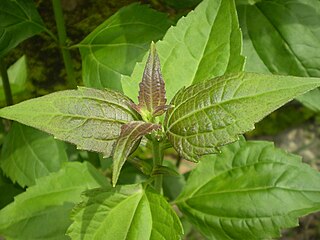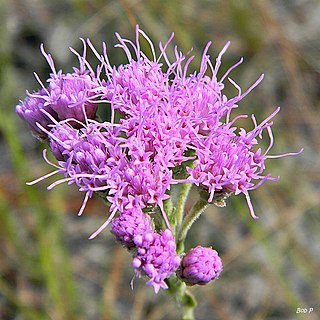
Xanthium (cocklebur) is a genus of flowering plants in the tribe Heliantheae within the family Asteraceae, native to the Americas and eastern Asia and some parts of south Asia.

Glebionis segetum is a species of flowering plant in the family Asteraceae, probably native only to the eastern Mediterranean region but now naturalized in western and northern Europe as well as China and parts of North America. Common names include corn marigold and corn daisy.
Harold Ernest Robinson was an American botanist and entomologist.

Liatris, commonly known as gayfeather and blazing star is a genus of flowering plants in the tribe Eupatorieae within the family Asteraceae native to North America. Some species are used as ornamental plants, sometimes in flower bouquets. They are perennials, surviving the winter and resprouting underground corms.

Eupatorium is a genus of flowering plants in the family Asteraceae, containing from 36 to 60 species depending on the classification system. Most are herbaceous perennials growing to 0.5–3 m (1.6–9.8 ft) tall. A few are shrubs. The genus is native to temperate regions of the Northern Hemisphere. Most are commonly called bonesets, thoroughworts or snakeroots in North America. The genus is named for Mithridates Eupator, king of Pontus.

Crepis capillaris, the smooth hawksbeard, is a species of flowering plant in the tribe Cichorieae within the family Asteraceae, and is native to Europe. It has become naturalized in other lands and is regarded as a weed in some places.

Chromolaena odorata is a tropical and subtropical species of flowering shrub in the family Asteraceae. It is native to the Americas, from Florida and Texas in the United States south through Mexico and the Caribbean to South America. It has been introduced to tropical Asia, West Africa, and parts of Australia.

Asparagus asparagoides, commonly known as bridal creeper, bridal-veil creeper, gnarboola, smilax or smilax asparagus, is a herbaceous climbing plant of the family Asparagaceae native to eastern and southern Africa. Sometimes grown as an ornamental plant, it has become a serious environmental weed in Australia and New Zealand.

Emilia sonchifolia, also known as lilac tasselflower or cupid's shaving brush, is a tropical flowering species of tasselflower in the sunflower family. It is widespread in tropical regions around the world, apparently native to Asia and naturalized in Africa, Australia, the Americas, and various oceanic islands.

Eutrochium is a North American genus of herbaceous flowering plants in the family Asteraceae. They are commonly referred to as Joe-Pye weeds. They are native to the United States and Canada, and have non-dissected foliage and pigmented flowers. The genus includes all the purple-flowering North American species of the genus Eupatorium as traditionally defined, and most are grown as ornamental plants, particularly in Europe and North America.

Mikania micrantha is a tropical plant in the family Asteraceae; known as bitter vine, climbing hemp vine, or American rope. It is also sometimes called mile-a-minute vine. It is known as Japani lota in Assam.

Hypochaeris glabra is a species of flowering plant in the tribe Cichorieae within the family Asteraceae known by the common name smooth cat's ear. It is native to Europe, North Africa, and the Middle East but it can be found on other continents where it is an introduced species and a widespread weed. It has become widespread in Africa, southern and southeastern Asia, Australia, and parts of the Americas.

Cuscuta campestris, with the common names field dodder, golden dodder, large-seeded alfalfa dodder, yellow dodder and prairie dodder, is a parasitic plant which belongs to the family Convolvulaceae. It was formerly classified in the family Cuscutaceae.

Callisia is a genus of flowering plants in the spiderwort family, Commelinaceae. Members of the genus are commonly known as roselings. It is native to the Western Hemisphere from the southern United States to Argentina. The generic name is derived from the Greek word κάλλος (kallos), meaning "beauty."

Garberia is a monotypic genus of flowering plants in the family Asteraceae, containing the single species Garberia heterophylla. It is endemic to Florida in the United States, where it is distributed in the northern and central counties. The plant is known commonly as garberia and Garber's scrub starts.

Carphephorus is a genus of North American plants in the family Asteraceae. They are native to the southeastern United States from Louisiana to Virginia. Plants of this genus are known commonly as chaffheads.

Melanthera, is a genus of perennial flowering plants in the family Asteraceae, native to North and South America, as well as Africa, Asia and Oceania, including Hawaiʻi.

Mikania scandens is a species of flowering plant in the family Asteraceae. Its common names include climbing hempvine, climbing hempweed, and louse-plaster. It is native to the eastern and central United States, with its distribution extending into Tamaulipas, Mexico. Reports of its presence in Ontario, Canada are erroneous. It is an introduced and invasive species on many Pacific Islands and in parts of southern Asia.

Ischaemum rugosum, also known as saramollagrass, is a flowering plant belonging to the grass family Poaceae in the genus Ischaemum, and is native to tropical and temperate regions of Asia, growing in marshes and other wet habitats. It is a vigorous annual, and is an invasive species in South America and Madagascar. It reaches heights of up to 1 m and is primarily recognized by the ridged surface of its sessile spikelet’s lower glume. Despite its historic importance as fodder in Asia, the grass has become a major weed in mid-latitude rice paddies throughout Asia and South America.

Rottboellia cochinchinensis is a species of grass known by the common names Itchgrass,Raoul grass, corngrass, Kokoma grass, Guinea-fowl grass, jointed grass, Shamwa grass and Kelly grass. It is a tall, tufted annual grass whose stems (culms) grow up to 3 metres in height with leaf-blades of up to 45 centimetres in length. The species flowers at the apex of culms in the form of spike-like racemes composed of paired spikelets. The common name Itchgrass comes from the bristly (hispid) leaf-sheath which can be irritating to the skin.



















